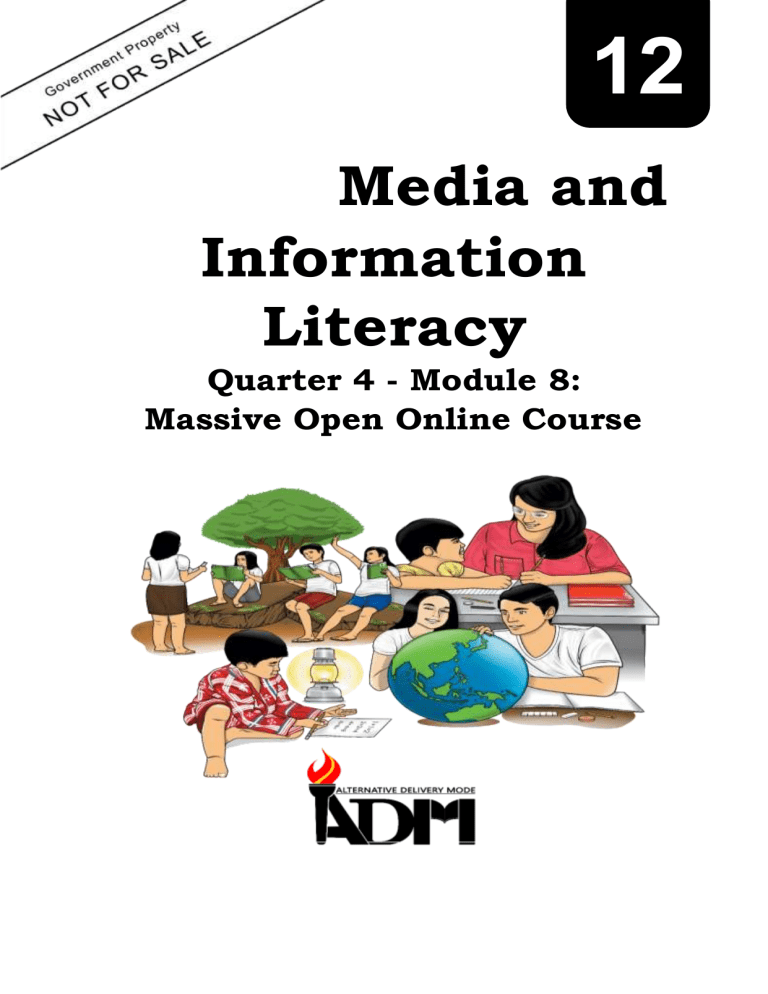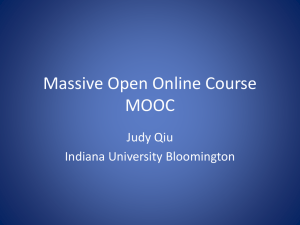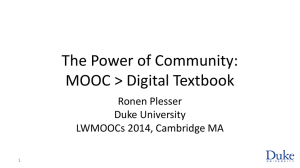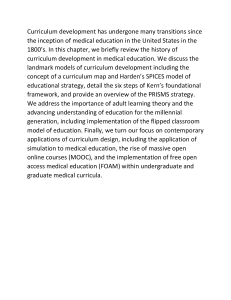
12 Media and Information Literacy Quarter 4 - Module 8: Massive Open Online Course What I Need to Know This module was designed and written to help you understand the concept and the types of one of the current trends in media and information which is the massive open online course. Knowing the nature of massive open online course including the advantages and limitations could help us to determine if a certain group of people or locality can utilize it. The scope of this module allows many different learning situations where students could identify their daily activities where aspects of massive open online course are being used. The use of language recognizes the diverse vocabulary levels of students. The lessons are arranged to follow the standard sequence of the course but the order in which you read them can be changed to correspond with the textbook you are now using. After going through this module, you are expected to describe the impact of massive open online (MIL11/12 CFT-IIIi-26). What I Know Read and answer each question carefully. Write the letter of the best answer on a separate sheet of paper. 1. 2. 3. Which of the following pertains to the knowledge or skill acquired by a person through instruction or study? A. Book C. Learning B. Reference D. Collaboration Which term means “able to move easily from place to place”? A. Accessibility C. Web site B. Mobile D. Blog Which is NOT a major massive open online course (MOOC) provider? A. Coursera C. Udacity B. Wikipedia D. EdX 4. What are the two main types of massive open online course (MOOC)? A. xMOOCs and cMOOCs C. xMOOCs and yMOOCs B. aMOOCs and bMOOCs D. sMOOCs and lMOOCs 5. What is defined as occurring or existing now? A. Upcoming B. Potential 6. C. Simultaneous D. Current Which is NOT an advantage of massive open online course (MOOC)? A. Feasibility C. Repetition B. Affordable D. With strict class schedules 5 7. What is referred to as a segment appearing as part of an online publication that typically relates to a subject, and sometimes contain articles and personal commentary by one or several authors? A. Video C. Twitter B. Recording D. Blog 8. What is described as a group of world wide web pages usually containing hyperlinks to each other and made accessible online by a person, company, institution, government agency, or organization? A. Blog C. Online B. Web site D. Channel 9. What do you call a model for delivering learning content online to anyone who needs to take a learning course with no limit in attendance and participation? A. Browsing C. 3D Environment B. Massive Open Online Course D. Wearable Technology 10. Which of the following pertains to the quality of being reached, used, or seen? A. Accessibility C. Attainability B. Permissively D. Usability Lesson Massive Open Online Course (MOOC) 1 You might not know it, but when your parents were younger, information was much harder, and more expensive, to come by. For information on a wide variety of topics, one had to consult an encyclopedia, a multi-volume collection of books with 6 alphabetically arranged topics. For word meanings, one used a dictionary which could be pocket-sized and concise or massive and comprehensive. For more complete information on a subject, there were textbooks and trade books. Except textbooks, which were widely available wherever they were required in school, these sources of information were mostly seen in public and private libraries. The information contained in books were relatively stable, that is, they do not change much over time, and new editions may not come for years. For new findings from academic research, one read journal publications and similar periodicals, which were available in university libraries. But, to keep abreast of current affairs, one read newspapers, listened to radio, or watched television. The 21st century has brought many technological advancements that led to the development of the different modes of transmitting and getting information. Products of technology have also resulted in a paradigm shift in the field of education – from the traditional use of printed information such as books, journals, magazines, encyclopedia and dictionary to using their digital or online versions. Now, information may also be gathered from reliable and credible websites and how-to videos on YouTube, all found using search engines such as Google, Yahoo, and Bing. The use of technology has also influenced the behavior of people towards choosing the format and path of getting information, shifting from the traditional classroom set-up to online-based learning, thus, making it easier to gain knowledge anytime and anywhere. https://www.flickr.com/photos/88031504@N00/2368123528 https://www.flickr.com/photos/tim_ellis/32824895204 This module will discuss one of the current trends in media and information dissemination the Massive Open Online Course (MOOC), and how it influences the behavior of people when it comes to learning new information. What’s In KWL Chart To check your prior knowledge about the topic and to solicit the questions that you want to know about it, fill in the Know and Want to Know components of the Know-Want to Know- Learned (KWL) chart properly and correctly. For the Know component, you may write word/s or sentence. For the Want to Know component, state your responses in question form. List as many responses as you want for each component. Write your responses on a separate sheet of paper. 7 Topic Know Want to Know Learned Massive Open Online Course (MOOC) Guide Questions 1. Based on what you have written on the Know component of the chart, what do you know about Massive Open Online Course (MOOC)? 2. If you were to think of a question that you want to ask about Massive Open Online Course (MOOC), what question would that be? Let’s have some fun! - Word Hunt Activity A password is needed to log in to a computer. Codes are listed below inside the term bank that could be used to determine the password of the computer. Encircle all the codes in the puzzle completely and properly. A K G T J B L O G J A O P N C S F O L I D X B N N E R W C I U M K T F H G L N E C N E G K I L P O E I A P M A S S I V E F G L N S E C V B N S A S F G I E H T P I U Y T I E D G C H K I G R S Z X C B V B A N M T H J U Y G D H I G R H M I E C O U R S E F L K H G O F G J O P E N W E I G H N G A R Y R A M O S F T G U O F E A S I B L I T Y I TERM BANK Course Blog Online Accessibility Repetition Open 8 Massive Feasibility What’s New Make Meaning: Internet Assisted Activity Describe the given word in each item correctly. You may use the internet to find the meaning of the words. WORD MEANING 1. Massive _____________________________________________ 2. Open 3. Online _____________________________________________ 4. Course _____________________________________________ 5. Feasibility _____________________________________________ 6. Blog 7. Accessibility _____________________________________________ 8. Repetition _____________________________________________ 9. Asynchronous _____________________________________________ _____________________________________________ _____________________________________________ What is It Massive Open Online Course (MOOC) MOOC is an acronym for Massive Open Online Course. The word “massive” means large number or amount, “open” means accessible to all, “online” means connected to or available through a system, and “course” means the act of moving in a path from point to point. Therefore, MOOC refers to a route or pattern of getting a content or information https://www.pxfuel.com/en/free -photo-ebzbi available through an online system that can be accessed by many people. MOOC is also described as a pattern for providing learning information or content online to any person who needs to take up a course with no limit on attendance. MOOCs are asynchronous web-based courses geared towards enabling several hundreds of students all over the world to enroll and learn from top world-renowned 9 academic institutions at the same time. MOOCs deliver content via recorded video lectures, online readings, and online assessments, with various degrees of studentstudent and student-instructor interactions. Many MOOC-providers offer free courses, which entice more people to enroll. There are MOOCs that provide certificates of completion to the students; however, most of them do not count for college credit. The concept of MOOC was invented in 2008 by Dave Cormier, from the University of Prince Edward Island, for a course offered by the University of Manitoba, "Connectivism and Connective Knowledge”, (https://whatis.techtarget.com/definition/massively-open-onlinecourseMOOC). The learning material or video content used in an MOOC is created by an educational institution, usually a university or a college that offers such programs. The organization and administration operation of an MOOC are coordinated by active MOOC platforms (e.g. Coursera and edX). MOOCs were created from the idea of covering an entire university course online and thereby making it accessible to everyone in the world. The intent was to "democratize" educational content from elite universities. Types of Massive Open Online Course (MOOC) There are two main types of MOOCs: 1. xMOOCs xMOOC stands for eXtended MOOC. xMOOCs are based on traditional university course structures and make use of established teaching approaches and materials. Students will watch pre-recorded lectures, complete required readings, and participate in discussions as produced and managed by a course instructor or an instructional team from a higher education institution. These are typically self-contained and rarely utilize content external to the main content delivery and learning platform. 2. cMOOCs cMOOC stands for Connectivist MOOC. cMOOCs are based on the connectivist learning model that favors collaboration among learners as a form of active learning. Students in cMOOC work together to locate, evaluate, and contribute to the course content by uploading materials in the form of tweets, blog posts, wikis and others, to the course using the learning platform. A cMOOC instructor or instructional team facilitates learning by finalizing, aggregating, and assessing the students’ contributions to the course. The following table illustrates the conceptual differences between cMOOCs and XMOOCs. xMOOCs Scalability of provision (e.g., offering university courses to a larger audience) Open access – Restricted license Individual learning in single platform cMOOCs Massive Open Online 10 Community and Connections Open access and license Networked learning across multiple platforms and services Acquire a curriculum of knowledge & skills Course Develop shared practices, knowledge and understanding Advantages of Massive Open Online Course (MOOC) https://www.igniteengineers.com/mooc-advantages-and-disadvantages/ 1. Relax requirements – MOOC can be taken by anyone who is interested in the subject matter and able to access the course, regardless of age, background, or location. 2. Video format availability - Teaching in a modern video format (not just texts like those that you’d find in other e-learning courses). 3. Accessibility- learning content from top universities like Harvard, Stanford, etc. can be opened through online format. 4. Repetition- an MOOC will often run two or three times a year, ensuring that students would not miss their chance. 5. High quality- MOOCs are led by subject matter experts (SMEs) and supported by teaching assistants, so that students have access to first-rate educational resources. 6. Feasibility- an MOOC usually requires 1-2 hours of study a week for about 5 weeks, making learning doable even for busy students. 7. Self-paced- an MOOC enables students to work through the course materials and assessments at their own pace. 8. Online collaboration- learners across the globe work together on common goals without the need to meet each other in person. What are some MOOC platforms? 11 There are already thousands of MOOCs from countless providers worldwide. Here are the top MOOC platforms. a. Coursera has over 20 million learners/participants. Courses were created by the universities of Stanford, Princeton, Yale, London, Munich, Zurich, and many more. b. EdX has around 10 million learners/participants. Courses were created from Harvard, MIT, Berkeley, and Oxford, among others. c. Udacity is created as an MOOC platform at Stanford. Now mostly programming courses in cooperation with industry partners such as Google, Facebook, or Daimler. Course topics include artificial intelligence and self-driving cars. d. FutureLearn is MOOC platform (UK-based) which includes various British and European universities. Courses offered are shorter in duration compared to others. What’s More Activity: Creating your own Massive Open Online Course Material Using your smartphone/laptop, create a Massive Open Online Course Material in the form of audio-visual presentation. The said material should focus on understanding corona virus and how this virus can be transmitted and prevented particularly at home and in school. The audio-visual material should not exceed 15 minutes. Use the audiovisual presentation rubric below to assess your output. OVERVIEW What is coronavirus? Coronaviruses are a type of virus that can cause respiratory disease in humans. The virus is called a "corona" because it has crown-like spikes on its surface. In 2019, a new coronavirus strain was discovered in Wuhan, China. How does the new coronavirus (COVID-19) spread from person to person? COVID-19 is likely spread: Close contact with an infected person can spread the coronavirus COVID-19. The virus spreads through the air in the form of respiratory droplets. You could get it if you inhale these droplets, but it's unlikely to be fatal. How long is a COVID-19 infected person considered infectious? If you have COVID-19, it can take several days for symptoms to appear — but you are infected during this time. Ten days after your symptoms began, you are no longer infectious. The best way to keep COVID-19 from spreading to others is to: Stay 6 feet away from others whenever possible. When you're around other people, put on a cloth mask that covers your mouth and nose. Wash your hands frequently. If soap isn't available, use a hand sanitizer containing at least 60% alcohol. 12 Avoid crowded indoor areas. Bring in as much fresh air as possible. If you are feeling ill and have symptoms that could be COVID-19, or if you have a positive COVID-19 test, stay at home. Surfaces that are frequently touched should be cleaned and disinfected. SYMPTOMS AND CAUSES What are the symptoms of the novel coronavirus (COVID-19) infection? The CDC says you may have coronavirus if you have these symptoms or a combination of symptoms: Fever or chills Cough Shortness of breath or difficulty breathing Tiredness Headaches New loss of taste or smell Others. Call 911 and get immediate medical attention if you have these warning signs Trouble breathing Persistent pain or pressure in your chest New confusion Inability to wake up from sleep This list does not include all possible symptoms. If you assume you have coronavirus or have any severe symptoms, consult a doctor. PREVENTION How can I prevent getting the novel coronavirus (COVID-19)? Getting vaccinated is your best defense against COVID-19. You should also take the same precautions you would take to avoid other viruses, such as the common cold or the flu. Wash your hands for at least 20 seconds before eating or preparing food, using the restroom, wiping your nose, or coming into contact with someone who has a cold. Wear a multilayered cloth facemask that fits comfortably over your mouth, nose, and chin. Close contact (within 6 feet) with those who have coughs, colds, or are ill should be avoided. If you are ill, stay at home. If you are prone to illness or have a weakened immune system, avoid large crowds. Follow the advice of your healthcare providers, especially during outbreaks. Using a virus-killing disinfectant, clean frequently used surfaces (such as doorknobs and countertops). If soap and water are not available, use hand sanitizers containing at least 60% alcohol. Instead of shaking hands, greet people with a friendly gesture. Get plenty of rest, eat a healthy diet, drink plenty of fluids, and exercise if you can. These steps will help to strengthen your immune system and make it easier to fight infections. Rubric – Audio-Visual Presentation INDICATORS CRITERIA Expert (4 points) Intermediate (3 points) 13 Novice (2 points) Beginner (1 point) Organization Information presented in a logical and very interesting sequence Information presented in a logical sequence Presentation jumps around and audience has difficulty following Audience cannot understand presentation because of weak organization Design All multimedia elements work well together and demonstrate excellent synthesis Multimedia elements are appropriate and enhance the presentation Selection of media elements are adequate Shows poor selection of graphics, fonts, sound, and video Content Covers the topic completely and in depth with a variety of resources. Encourages viewers to know more Includes essential information and facts to give viewers an understanding of the topic Includes some essential information with a few citations and facts Includes little essential information and one or two facts Graphics Graphics explain and reinforce message of presentation Graphics vary and relate to presentation Occasionally uses graphics, but rarely support presentation Poor use of graphics or no graphics Sound Excellent use of sound and music to reinforce message Sound and music are used to convey message. Audio is clear. Some use of sound, but poor quality. Audience has trouble understanding Poor use of sound or no sound used http://citeseerx.ist.psu.edu/viewdoc/download?doi=10.1.1.97.9516&rep=rep1&type=pdf What I Have Learned The students will fill in the Learned component of the KWL chart to generalize the things they learned about the topic. KWL Chart Topic Know Want to Know Massive Open Online Course 14 Learned What I Can Do Work In Progress You are tasked to create a blog about the effects of Earthquake in your local community. Use the Blog Post rubric below to assess your output. Rubric – Blog Post INDICATORS CRITERIA Expert (4 points) The blog has a clear purpose to share and collect opinions and information about an important and interesting topic. The blog is fair and balanced. Blogger refers to information from a variety of viewpoints and draw original conclusions based on research. Intermediate (3 points) The purpose of the blog is to share information and the blogger’s opinions about an important topic. Novice (2 points) The blog is mostly about one topic, but sometimes the blogger gets off the subject. Beginner (1 point) The blog appears to be about unconnected topics and events. The blog is fair. Blogger refers to information from more than one viewpoint and draw conclusions based on research. The blogger tries to be fair in the blog, but the information presented is missing critical content. I try to draw conclusions, but sometimes my conclusions are not based on research. The blogger presents one viewpoint on the topic. Do not draw conclusions about the research, but just repeat what other sources have said about the topic Sources The blogger gathered extensive information from a variety of reliable sources outside the classroom. Cites the sources correctly. The blogger gathered information from some reliable sources outside the classroom. Cites all the sources with no or very few minor errors. Most of the information on the blog comes from the opinions. The blogger cites only one or two sources, or the citations have numerous errors. The information of the blog is opinion, without any sources to back it up. Audience My writing engages my readers. I ask good questions and describe interesting ideas to get my readers to respond. I think about what my readers want to know and write my blog entries to answer their questions and concerns. I try to think about Poor use of my readers and graphics or no answer their graphics questions, but most of the time I just write about what I am interested in or what is easy to find. Purpose Content 15 Sound Excellent use of sound and music to reinforce message Sound and music are used to convey message. Audio is clear. Voice Writing shows the Writing shows that personality of the the blogger care blogger and about the topic. reflects a deep commitment to the topic. Some use of sound, but poor quality. Audience has trouble understanding I rarely think about how my readers will respond to my blog. I write about what is interesting to me or is easy to find. Writing sometimes shows that the blogger care about the topic. Writing sounds like that the blogger is just completing an assignment without caring about the topic. https://www.ffc8.org/cms/lib/CO01900636/Centricity/Domain/728/21_Blog_Rubric.pdf Assessment Read and answer each statement carefully. Then, write the letter of the best answer on a separate sheet of paper. 1. Mr. Ramos, a professor in a University, is teaching online to a number of students from different parts of the country and overseas using his uploaded videos about the different parts and functions of the human body. Which medium is being used here? A. 3D C. Ubiquitous Learning B. Massive Open Online Course D. Wearable technology 2. _____ are based on connectivist learning models that favors collaboration as a form of active learning. A. cMOOCs B. xMOOCs C. Google D. Yahoo 3. Which of the following is NOT massive open online flatform? A. Google B. Coursera C. Edx D. Udacity 4. ____ are based on traditional course structures and make use of established teaching approaches and materials A. cMOOCs B. xMOOCs C. Google D. Yahoo 5. ____ enables students to work through the course materials and assessments at their own rates while also interacting with a global learning community. A. Accessibility B. Feasibility C. Repetition D. Self-paced 6. Erwin is watching a video about renowned Filipino scientists on his tablet in the assigned learning station. Next, he will transfer to the next learning station to watch the different Filipino folk dances. Which medium is being used here? A. 3D C. Ubiquitous Learning B. Massive Open Online Course D. Wearable technology 7. ____ is an advantage of MOOC in which a course runs two or three times a year, ensuring that students would not miss their chance A. Accessibility C. Repetition B. Feasibility D. Self-paced 8. Mary Anne realized that she forgot to answer the guide questions in one of the learning stations in the Science class. She decided to log in to her account as 16 soon as she got home. Which characteristic of ubiquitous learning is shown in the situation? A. Accessibility C. Interactivity B. Permanency D. Adaptability 9. Which of the following is NOT an advantage of Mass Open Online Course? A. Teaching in a modern video format B. Courses in a true online format C. Online interaction between learners and teachers D. Uses paper and pencil test in evaluating students 10. Who invented the concept of Massive Open Online Course or MOOC in 2008? A. Bill Gates C. Mark Zuckerberg B. Dave Cormier D. Jeff Bezos 17


